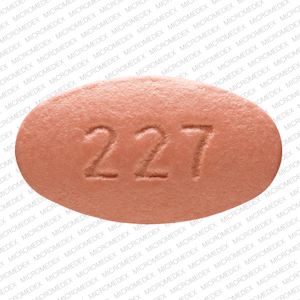Raltegravir Dosage
Medically reviewed by Drugs.com. Last updated on Apr 4, 2025.
Applies to the following strengths: 400 mg; 25 mg; 100 mg; 600 mg
Usual Adult Dose for:
Usual Pediatric Dose for:
Additional dosage information:
Usual Adult Dose for HIV Infection
Therapy-naive patients or patients virologically-suppressed on an initial regimen of the 400 mg film-coated tablets twice a day:
600 mg film-coated tablets: 1200 mg orally once a day
400 mg film-coated tablets: 400 mg orally twice a day
Therapy-experienced patients:
400 mg film-coated tablets: 400 mg orally twice a day
Use: In combination with other antiretroviral agents, for the treatment of HIV-1 infection
Usual Adult Dose for Occupational Exposure
US Public Health Service Working Group Recommendations:
400 mg film-coated tablets: 400 mg orally twice a day
Duration of therapy: 28 days, if tolerated
Comments:
- This drug plus emtricitabine-tenofovir disoproxil fumarate is recommended as the preferred regimen for HIV postexposure prophylaxis; this drug is also recommended as a component in various alternative regimens.
- Prophylaxis should be started as soon as possible, preferably within hours after exposure.
- The optimal duration of prophylaxis is unknown and may differ based on institution protocol.
- Current guidelines should be consulted for additional information.
Usual Adult Dose for Nonoccupational Exposure
US CDC Recommendations:
400 mg film-coated tablets: 400 mg orally twice a day
Duration of therapy: 28 days
Comments:
- This drug is recommended as a component of a preferred 3-drug regimen for nonoccupational postexposure prophylaxis of HIV infection; if other alternatives are considered, this drug is recommended as a component in various regimens.
- Prophylaxis should be started as soon as possible, within 72 hours of exposure.
- Current guidelines should be consulted for additional information.
Usual Pediatric Dose for HIV Infection
ORAL SUSPENSION:
Full-Term Neonates (Birth to 4 Weeks [28 Days] of Age):
Birth to 1 week:
- Weight 2 to less than 3 kg: 4 mg orally once a day
- Weight 3 to less than 4 kg: 5 mg orally once a day
- Weight 4 to less than 5 kg: 7 mg orally once a day
1 to 4 weeks:
- Weight 2 to less than 3 kg: 8 mg orally twice a day
- Weight 3 to less than 4 kg: 10 mg orally twice a day
- Weight 4 to less than 5 kg: 15 mg orally twice a day
Pediatric Patients At Least 4 Weeks of Age:
- Weight 3 to less than 4 kg: 25 mg orally twice a day
- Weight 4 to less than 6 kg: 30 mg orally twice a day
- Weight 6 to less than 8 kg: 40 mg orally twice a day
- Weight 8 to less than 10 kg: 60 mg orally twice a day
- Weight 10 to less than 14 kg: 80 mg orally twice a day
- Weight 14 to less than 20 kg: 100 mg orally twice a day
CHEWABLE TABLETS:
Pediatric Patients At Least 4 Weeks of Age:
- Weight 3 to less than 6 kg: 25 mg orally twice a day
- Weight 6 to less than 10 kg: 50 mg orally twice a day
- Weight 10 to less than 14 kg: 75 mg orally twice a day
- Weight 14 to less than 20 kg: 100 mg orally twice a day
- Weight 20 to less than 28 kg: 150 mg orally twice a day
- Weight 28 to less than 40 kg: 200 mg orally twice a day
- Weight at least 40 kg: 300 mg orally twice a day
400 MG FILM-COATED TABLETS:
- Weight at least 25 kg: 400 mg orally twice a day
600 MG FILM-COATED TABLETS:
- Weight at least 40 kg and either therapy-naive or virologically-suppressed on an initial regimen of the 400 mg film-coated tablets twice a day: 1200 mg orally once a day
Maximum dose:
- Oral suspension: 100 mg twice a day
- Chewable tablets: 300 mg twice a day
Comments:
- Neonates: If the mother used this drug 2 to 24 hours before delivery, the neonate's first dose should be administered between 24 and 48 hours after birth.
- Neonates, birth to 1 week of age: The dosing recommendations are based on about 1.5 mg/kg/dose.
- Neonates, 1 to 4 weeks of age: The dosing recommendations are based on about 3 mg/kg/dose.
- Pediatric patients at least 4 weeks of age: The weight-based dosing recommendation for the oral suspension and chewable tablets is based on about 6 mg/kg/dose twice a day.
- The oral suspension can be used in patients who weigh 2 to less than 20 kg; the chewable tablets can be used in patients at least 4 weeks of age who weigh at least 3 kg.
- The 400 mg film-coated tablets may be used in pediatric patients who weigh at least 25 kg if able to swallow a tablet.
Use: In combination with other antiretroviral agents, for the treatment of HIV-1 infection
Usual Pediatric Dose for Nonoccupational Exposure
US CDC Recommendations:
ORAL SUSPENSION:
Pediatric Patients At Least 4 Weeks of Age:
- Weight 3 to less than 4 kg: 25 mg orally twice a day
- Weight 4 to less than 6 kg: 30 mg orally twice a day
- Weight 6 to less than 8 kg: 40 mg orally twice a day
- Weight 8 to less than 10 kg: 60 mg orally twice a day
- Weight 10 to less than 14 kg: 80 mg orally twice a day
- Weight 14 to less than 20 kg: 100 mg orally twice a day
CHEWABLE TABLETS:
Pediatric Patients At Least 4 Weeks of Age:
- Weight 3 to less than 6 kg: 25 mg orally twice a day
- Weight 6 to less than 10 kg: 50 mg orally twice a day
- Weight 10 to less than 14 kg: 75 mg orally twice a day
- Weight 14 to less than 20 kg: 100 mg orally twice a day
- Weight 20 to less than 28 kg: 150 mg orally twice a day
- Weight 28 to less than 40 kg: 200 mg orally twice a day
- Weight at least 40 kg: 300 mg orally twice a day
400 MG FILM-COATED TABLETS:
- Weight at least 25 kg: 400 mg orally twice a day
Maximum dose:
- Oral suspension: 100 mg twice a day
- Chewable tablets: 300 mg twice a day
Duration of therapy: 28 days
Comments:
- This drug is recommended as a component of a preferred (or alternative) 3-drug regimen for nonoccupational postexposure prophylaxis of HIV infection in children at least 4 weeks of age (and a postmenstrual age of at least 42 weeks); if other alternatives are considered, this drug is recommended as a component in various regimens.
- A pediatric HIV-specialist should be consulted for neonates (aged 0 to 27 days).
- Prophylaxis should be started as soon as possible, within 72 hours of exposure.
- The oral suspension can be used in patients who weigh less than 20 kg; the chewable tablets can be used in patients who weigh at least 3 kg.
- The 400 mg film-coated tablets may be used in pediatric patients who weigh at least 25 kg if able to swallow a tablet.
- Current guidelines should be consulted for additional information.
Renal Dose Adjustments
Any degree of renal dysfunction: No adjustment recommended.
Liver Dose Adjustments
400 mg film-coated tablets, chewable tablets, oral suspension:
- Mild to moderate liver dysfunction: No adjustment recommended.
- Severe liver dysfunction: Data not available
600 mg film-coated tablets:
- Liver dysfunction: Not recommended.
Dose Adjustments
Concomitant rifampin:
400 mg film-coated tablets:
- Adults (therapy-naive or therapy-experienced): 800 mg orally twice a day
- Pediatrics patients (younger than 18 years): Data not available
Precautions
CONTRAINDICATIONS: None
This drug is not recommended for use in preterm neonates or pediatric patients weighing less than 2 kg.
Consult WARNINGS section for additional precautions.
Dialysis
Data not available
Comments:
- Dosing before a dialysis session should be avoided; extent that drug may be dialyzable unknown.
Other Comments
Administration advice:
- Due to different pharmacokinetic profiles, do not substitute the chewable tablets or oral suspension for either film-coated tablet and do not substitute the 400 mg film-coated tablet for the 600 mg film-coated tablet to create a 1200 mg once-daily dose.
- Administer with or without food.
- Film-coated tablets: Swallow whole.
- If a pediatric patient weighing at least 25 kg is unable to swallow a 400 mg film-coated tablet, use the chewable tablet regimen.
- Chewable tablets: May chew or swallow whole; the 25 mg chewable tablet may be crushed if a child has difficulty chewing it.
- After preparation of the crushed tablet, immediately administer the entire dose orally; if any portion of the dose remains in the cup, add another teaspoonful (about 5 mL) of liquid, swirl, and administer immediately.
- Oral suspension: Do not shake; administer within 30 minutes of mixing.
- Do not use this drug with antacids that contain aluminum and/or magnesium; additionally, do not coadminister the 600 mg film-coated tablets with calcium carbonate antacids.
- Consult the manufacturer product information regarding missed doses.
Storage requirements:
- Store at 20C to 25C (68F to 77F); excursions permitted to 15C to 30C (59F to 86F).
- Film-coated and chewable tablets: Store in original package with bottle closed tightly; keep desiccant in bottle to protect from moisture.
- Oral suspension: Store in original container; do not open foil packet until ready for use.
Reconstitution/preparation techniques:
- To prepare the crushed 25 mg chewable tablet for children with difficulty chewing it:
- Place tablet(s) in small clean cup.
- Add a teaspoonful (about 5 mL) of liquid (e.g., water, juice, breast milk) for each tablet; the tablet will absorb the liquid and fall apart within 2 minutes.
- Crush any remaining pieces of the tablet(s) with a spoon.
- Oral suspension: The manufacturer product information should be consulted.
General:
- The 100 mg chewable tablet can be divided into equal halves.
- The 25 and 100 mg chewable tablets contain about 0.05 and 0.1 mg phenylalanine, respectively, which can be harmful to patients with phenylketonuria.
- Each single-use packet for oral suspension contains 100 mg of raltegravir; when suspended, the final concentration is 10 mg/mL.
Patient advice:
- Read the US FDA-approved patient labeling (Patient Information and Instructions for Use).
- Contact healthcare provider at once if rash develops; stop this drug and other suspect agents immediately and seek medical attention if rash associated with any of the following symptoms develop: fever, general ill feeling, extreme tiredness, muscle/joint aches, blisters/peeling of skin, oral blisters/lesions, eye inflammation, facial swelling, swelling of eyes/lips/mouth, difficulty breathing, and/or signs/symptoms of liver problems (e.g., yellowing of skin/whites of eyes, dark/tea-colored urine, pale-colored stools/bowel movements, nausea, vomiting, loss of appetite, pain/aching/sensitivity on right side below ribs).
- Notify healthcare provider at once of any symptoms of infection.
- If unexplained muscle pain, tenderness, or weakness occurs, contact healthcare provider at once.
More about raltegravir
- Check interactions
- Compare alternatives
- Reviews (18)
- Side effects
- During pregnancy
- Drug class: integrase strand transfer inhibitor
- Breastfeeding
- En español
Patient resources
Other brands
Professional resources
Other brands
Related treatment guides
See also:
Further information
Always consult your healthcare provider to ensure the information displayed on this page applies to your personal circumstances.


